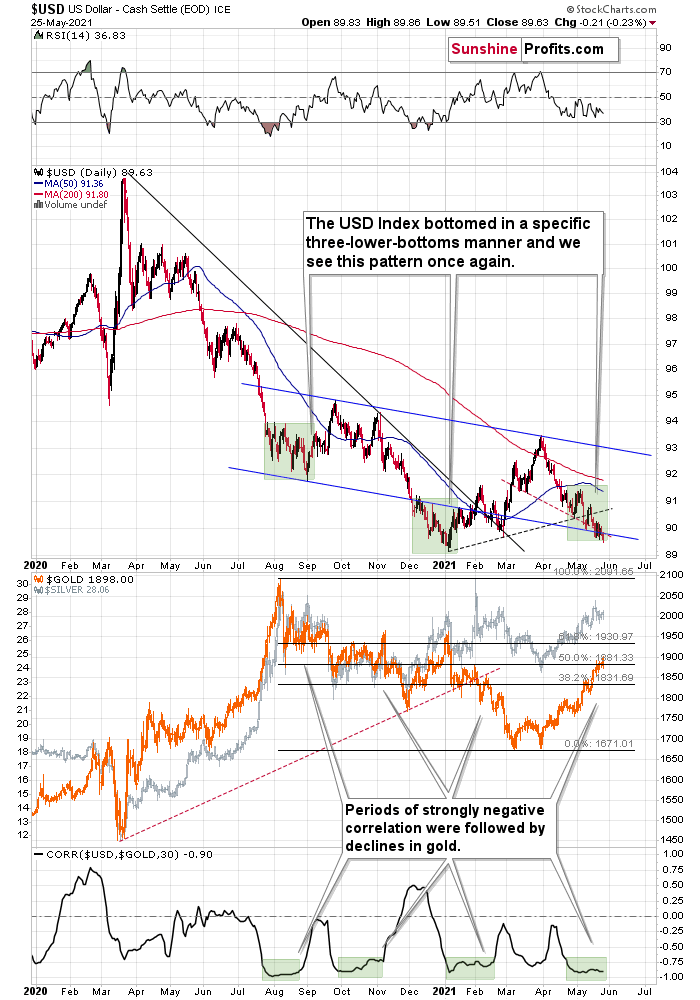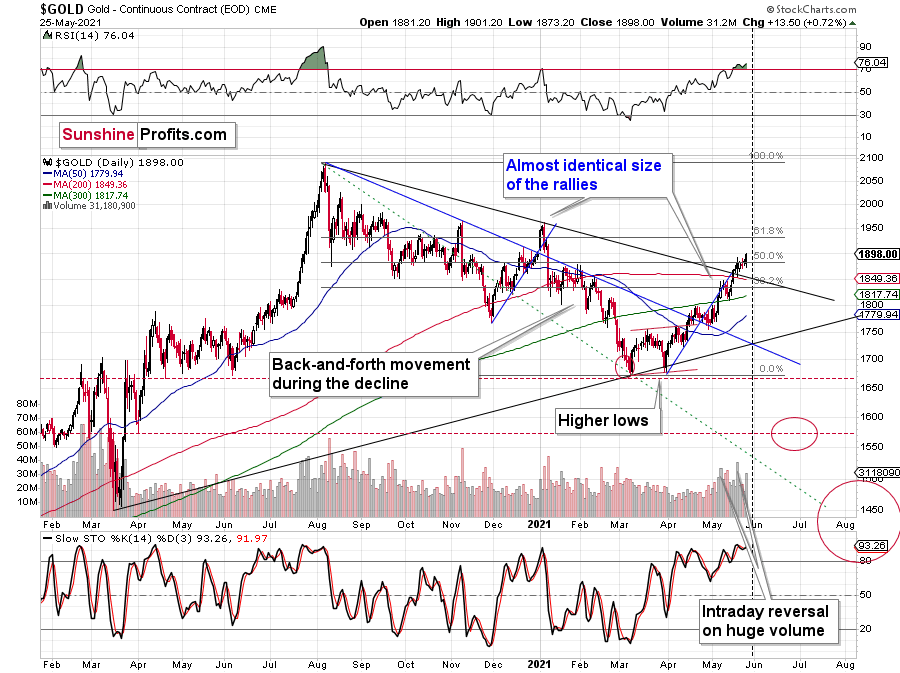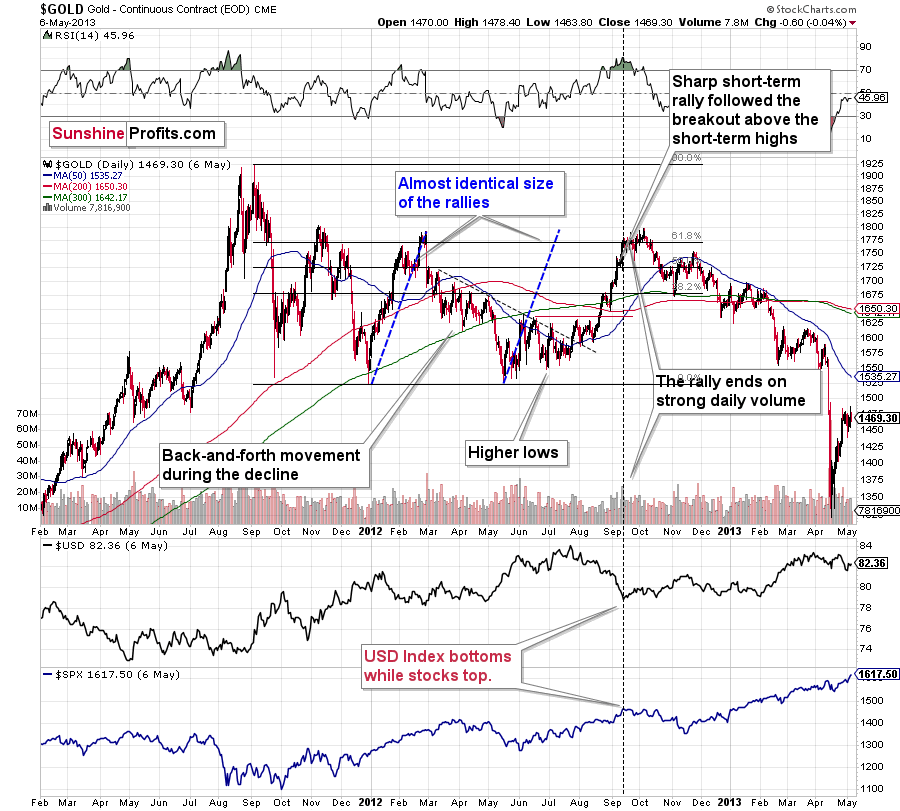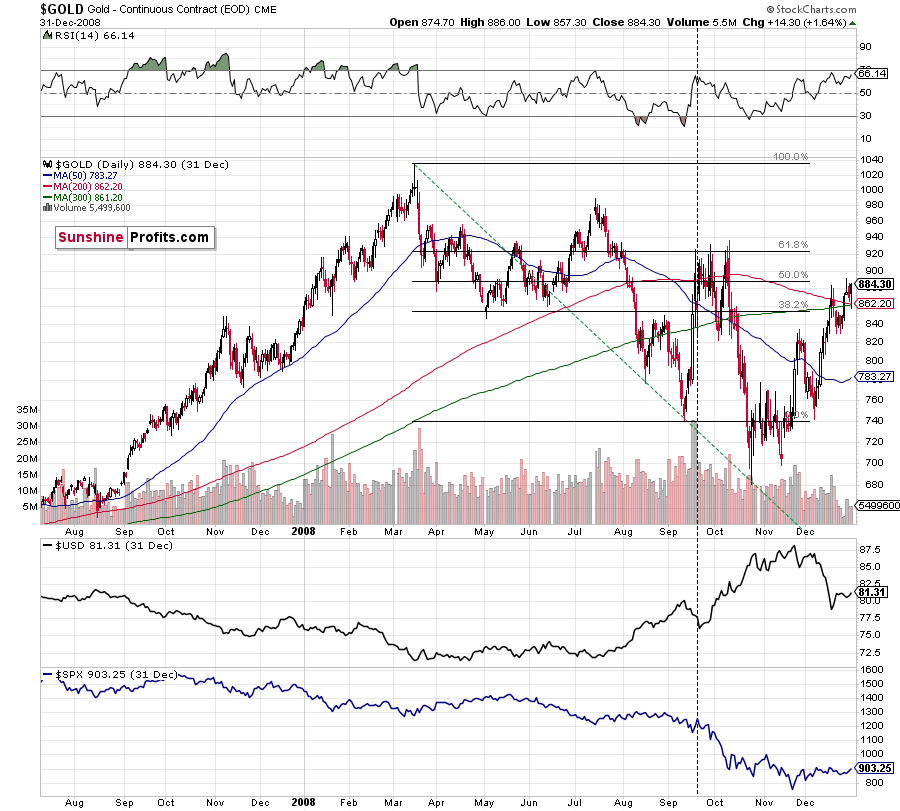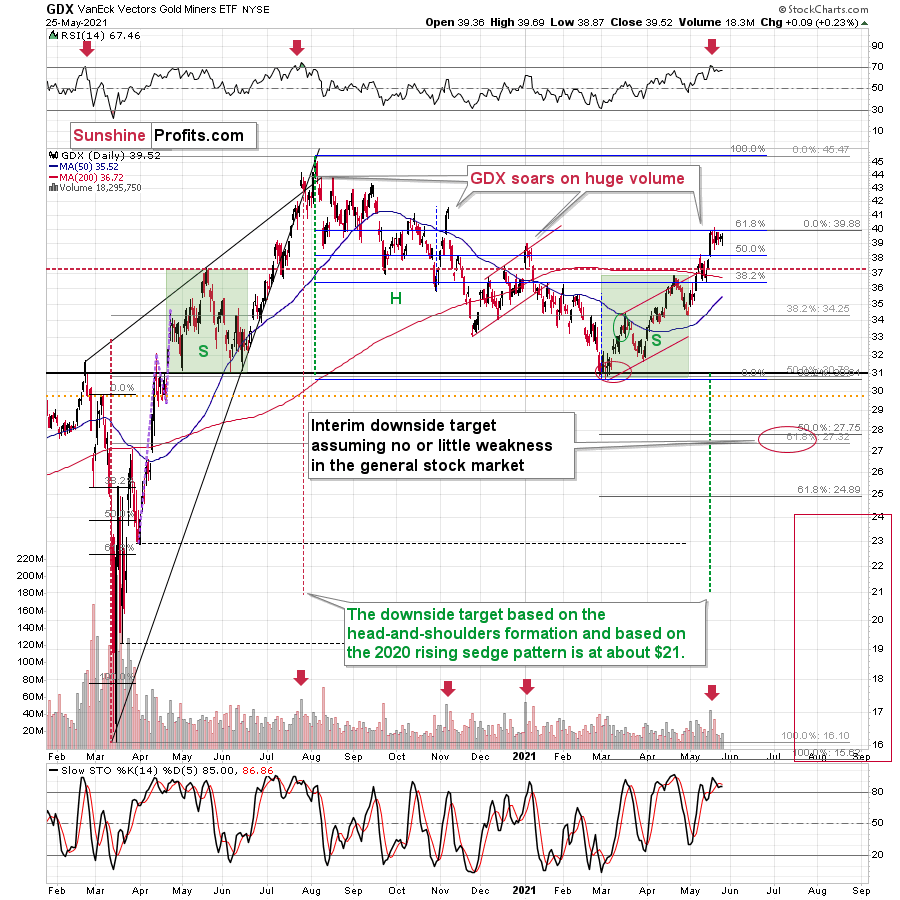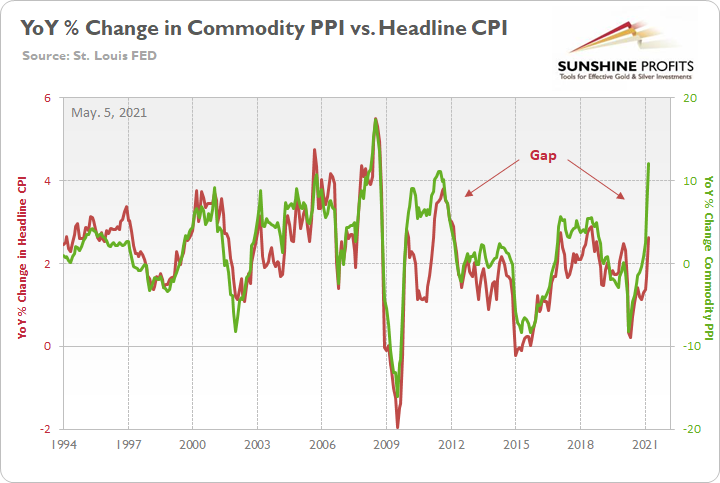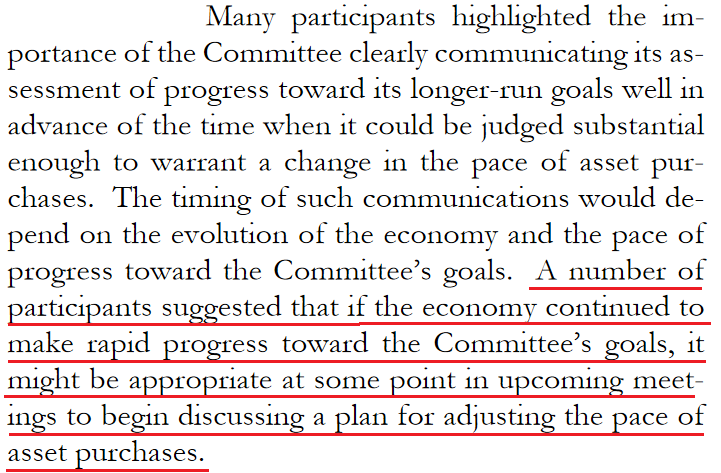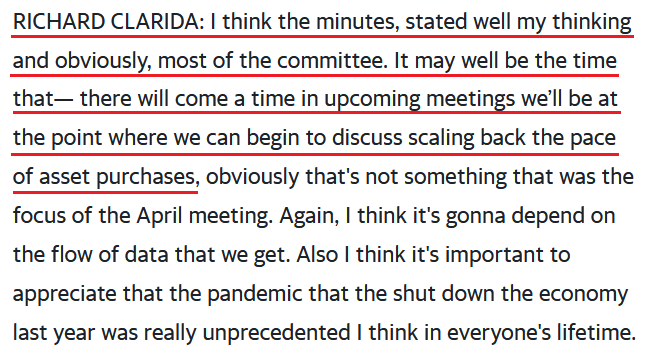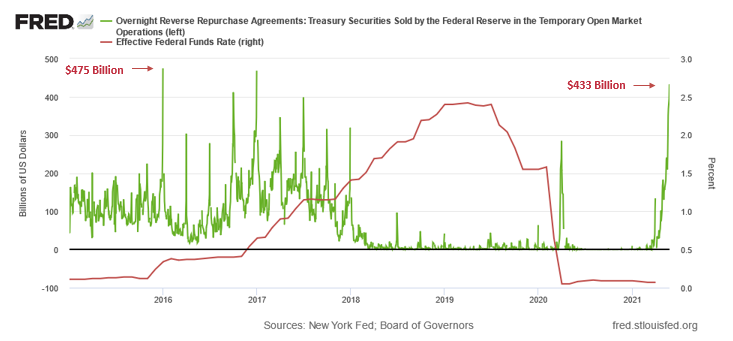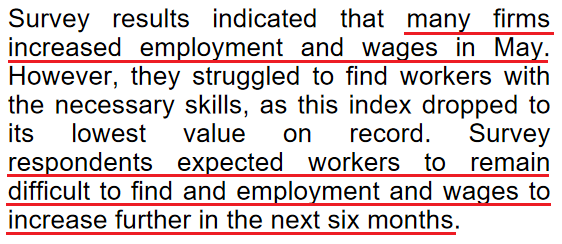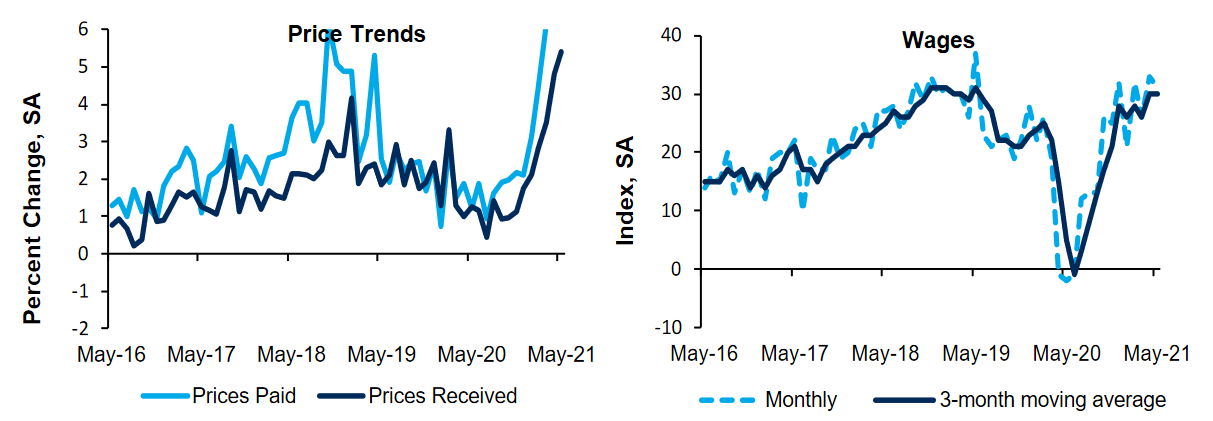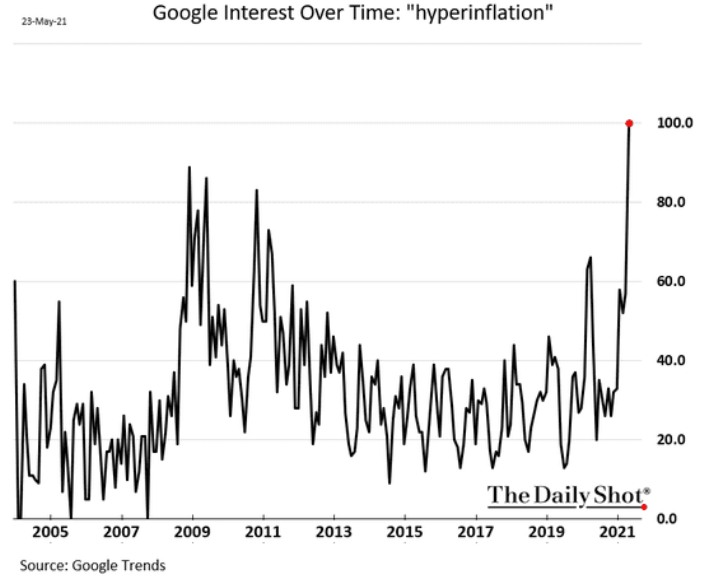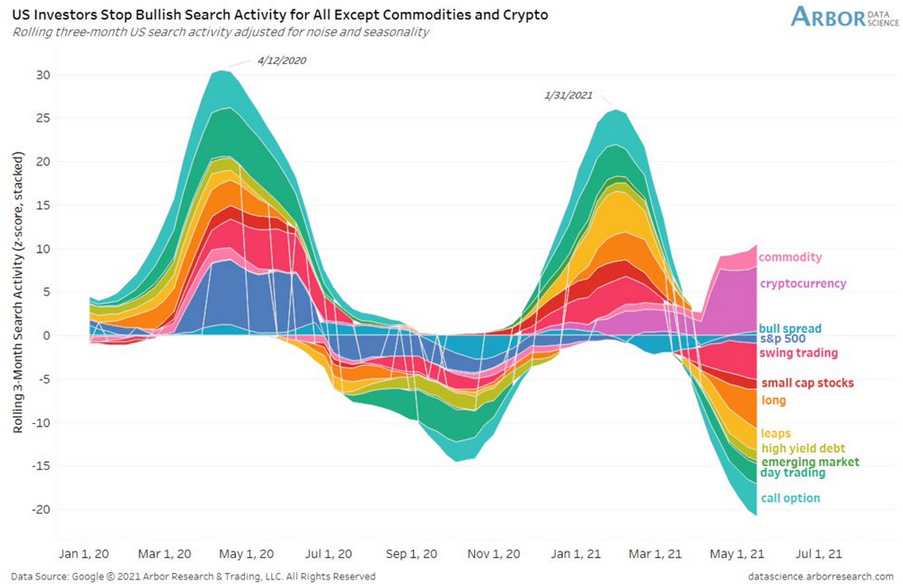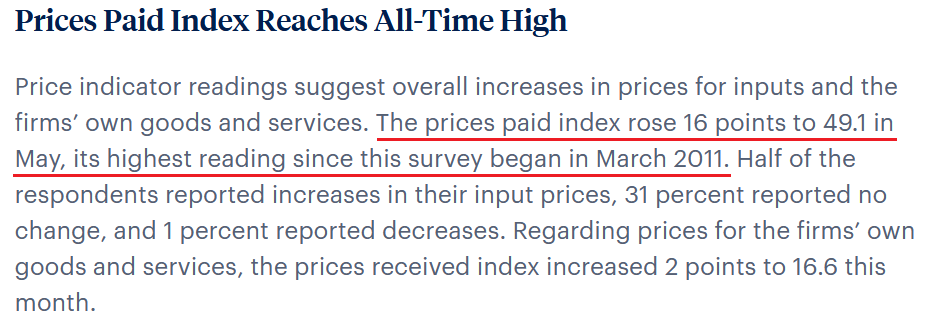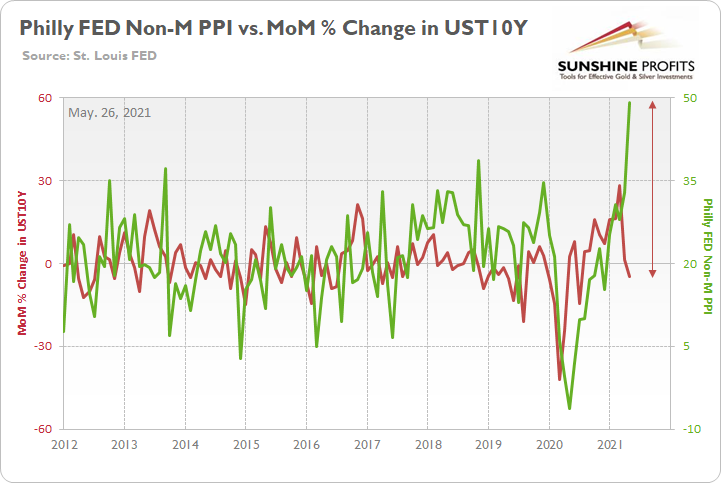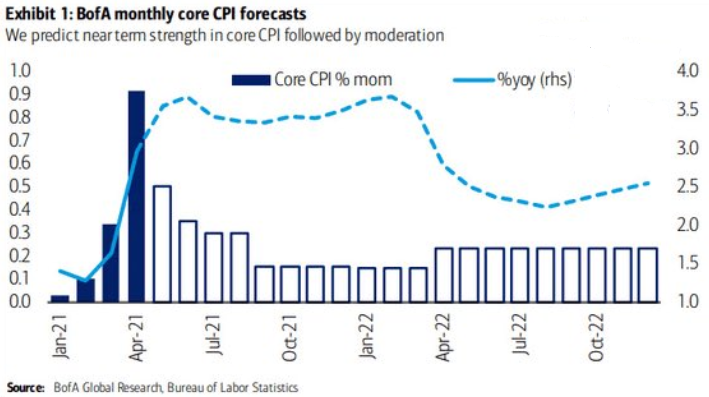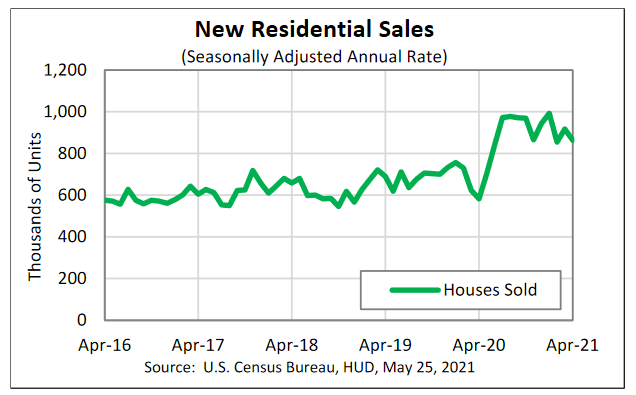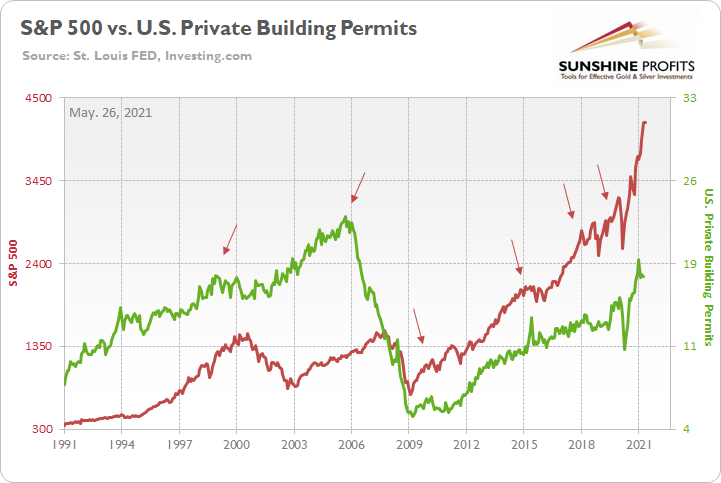Briefly: in our opinion, full (300% of the regular position size) speculative short positions in mining stocks are justified from the risk/reward point of view at the moment of publishing this Alert.
Gold just moved higher once again, but mining stocks refused to follow. This is one of the most reliable indications that a top is being formed.
Before moving to the precious metals sector, let’s take a look at the USD Index.
When I described the above chart yesterday (May 25), I wrote that the USD Index had been trading at about 89.6. Since this is the level at which the USD Index closed the day (approximately), practically everything that I wrote about its chart remains up-to-date:
This week’s move lower is a continuation, and most likely the final part, of a specific multi-bottom pattern that the USD Index exhibited recently.
I marked those situations with green. The thing is that the U.S. currency first declined practically without any corrections, but at some point it started to move back and forth while making new lows. The third distinctive bottom was the final one. Interestingly, the continuous decline took place for about a month, and the back-and-forth declines took another month (approximately). In July 2020, the USDX fell like a rock, and in August it moved back and forth while still declining. In November 2020, the USDX fell like a rock (there was one exception), and in December it moved back and forth while still declining.
Ever since the final days of March, we’ve seen the same thing all over again. The USD Index fell like a rock in April, and in May we’ve seen back-and-forth movement with lower lows and lower highs.
What we see right now is the third of the distinctive lows that previously marked the end of the declines.
And what did gold do when the USD Index rallied then?
In August, gold topped without waiting for USD’s final bottom – which is natural, given how extremely overbought it was in the short term.
In early January, gold topped (which was much more similar to the current situation given the preceding price action) when the USDX formed its third, final distinctive bottom.
The USD Index is after a two-month decline, half of which was the back-and-forth kind of decline. It’s forming the third – and likely the final – bottom, and gold just refused to react positively to this situation in today’s pre-market trading.
This might be “it” – the markets might be forming their final reversals here, starting to follow the most bearish (in the case of gold) part of the analogy to the price action in 2008 and 2012.
The Repeating Pattern
Gold has now moved higher, and it even moved slightly above $1,900 in today’s pre-market trading, which seems positive. But it doesn’t change anything with regard to gold’s analogies to how it performed in 2008 and 2012 right before the slide.
Gold seems to be insisting on repeating – to some extent – its 2012 performance, and – to some extent – its 2008 performance. Either way, it seems that gold is about to slide.
The initial reversal in gold took place after gold moved very close to its mid-January highs and the 50% Fibonacci retracement based on the August 2020 – March 2021 decline. Yesterday’s close was the first close above this important resistance, so the breakout was not confirmed.
The sizes of the current rally (taking the second March bottom as the starting point) and the rally that ended at the beginning of this year are practically identical at the moment. The current move is only a little bigger.
Just as the rallies from early 2012 and late 2012 (marked with blue) were almost identical, the same could happen now.
The March 2021 low formed well below the previous low, but as far as other things are concerned, the current situation is similar to what happened in 2012.
The relatively broad bottom with higher lows is what preceded both final short-term rallies – the current one, and the 2012 one. Their shape as well as the shape of the decline that preceded these broad bottoms is very similar. In both cases, the preceding decline had some back-and-forth trading in its middle, and the final rally picked up pace after breaking above the initial short-term high.
Interestingly, the 2012 rally ended on huge volume, which is exactly what we saw also on May 19 this year. Consequently, forecasting much higher gold prices here doesn’t seem to be justified based on the historical analogies.
The thing I would like to emphasize here is that gold didn’t form the final top at the huge-volume reversal on Sep. 13, 2012. It moved back and forth for a while and moved a bit above that high-volume top, and only then the final top took place (in early October 2012).
The same happened in September and in October 2008. Gold reversed on huge volume in mid-September, and it was approximately the end of the rally. The final top, however, formed after some back-and-forth trading and a move slightly above the previous high.
Consequently, the fact that gold moved a bit above its own high-volume reversal (May 19, 2021) is not an invalidation of the analogy, but rather its continuation.
There’s one more thing I would like to add, and it’s that back in 2012, gold corrected to approximately the 61.8% Fibonacci retracement level – furthermore, the same happened in 2008 as you can see in the below chart. Consequently, the fact that gold moved above its 50% Fibonacci retracement doesn’t break the analogy either. And even if gold moves to $1,940 or so, it will not break it. It’s not likely that it is going to move that high, as in both cases –in 2008 and 2012 – gold moved only somewhat above its high-volume reversal before forming the final top. So, as this year’s huge-volume reversal took place close to the 50% retracement and not the 61.8% retracement, it seems that we’ll likely see a temporary move above it, which will create the final top. And that’s exactly what we see happening so far this week.
The lower part of the above chart shows how the USD Index and the general stock market performed when gold ended its late-2012 rally and was starting its epic decline. In short, that was when the USD Index bottomed, and when the general stock market topped.
Back in 2008, gold corrected to 61.8% Fibonacci retracement, but it stopped rallying approximately when the USD Index started to rally, and the general stock market accelerated its decline. This time the rally was not as volatile, so the lower – 50% Fibonacci retracement level will hold the rally in check.
Taking into consideration that the general stock market has probably just topped, and the USD Index is about to rally, then gold is likely to slide for the final time in the following weeks/months. Both above-mentioned markets support this bearish scenario and so do the self-similar patterns in terms of gold price itself.
While gold moved to new highs, the GDX ETF didn’t (and neither did silver).
It moved mere nine cents higher and this move took place on relatively low volume – making that a bearish indication, not a bullish one.
Having said that, let’s take a look at the markets from a more fundamental angle.
The Chorus Grows Louder
For weeks, I’ve been warning that the U.S. Federal Reserve (FED) is likely to reduce its bond-buying program much sooner than investors expect.
On Apr. 30, I wrote:
With inflationary pressures building and the writing largely on the wall, a material Eurodollar options position signals that a hawkish shift could occur. With the FED’s annual Jackson Hole Symposium held in late August – where Powell unveiled a new policy framework for inflation in 2020 and then-FED Chair Ben Bernanke teased more bond purchases in 2012 – this year’s event could result in similar fireworks.
And while the chorus of FED speakers often promise the contrary, notice what Vice Chairman Richard Clarida told Yahoo! Finance on May 25?
“On the inflation outlook, obviously the CPI number that we got recently was a very unpleasant surprise. We and other forecasters had expected both PCE and CPI inflation to move up on reopening but that increase certainly caught my eye and others’ attention, Brian I continue to believe as my baseline case that this will prove to be largely transitory and I think the details of that recent report are consistent with that, but let me also emphasize, we're going to be looking at the data very closely in coming months.”
For context, for those of us that have been paying attention, April’s CPI print (released on May 12) wasn’t much of a “surprise.”
On top of that, while investors largely ignored the FED’s latest minutes, I wrote on May 20:
While the daily deluge of FED speakers say that “it’s too early” to slow down their bond purchases, behind closed doors, they’re singing a different tune. Case in point: with the FOMC releasing its latest minutes on May 19, notice the sudden change in tone?
The phrase “a number of participants suggested” is extremely important. Not only does it signal a material shift in the FED’s disposition, but it’s important to remember that the discussion covered the “meeting held on April 27–28, 2021.” Thus, while FED officials have been denying the prospect publicly, they’ve been keenly aware of the rising risks for weeks. On top of that, the statement was made before the core Consumer Price Index (CPI) surged by 0.92% month-over-month (MoM) on May 12 – the largest MoM percentage increase since September 1981.
Now, for the important reveal: notice how a sudden change in tone has morphed into increasingly hawkish rhetoric?
Moreover, did you notice the unintentional slip? “It may well be the time.” While he paused and caught himself by clarifying “there will come a time,” he essentially let the cat out of the bag. What’s more, the revelation comes one day after the FED’s daily reverse repos surged to nearly $400 billion.
For context, I wrote on May 25:
With U.S. financial institutions currently flooded with excess liquidity, they’re shipping cash to the FED at an alarming rate. Reverse repos surged to nearly $400 billion on May 24 and when a prior spike above $400 billion occurred in December 2015, the FED’s rate-hike cycle began. Thus, with current inflation dwarfing 2015 levels and U.S. banks practically throwing cash at the FED, is this time really different?
And while the momentum keeps building, what a difference a day makes! Case in point: with the FED’s daily reverse repos hitting $433 billion on May 25, the ominous milestone has officially been reached.
Please see below:
To explain, the green line above tracks the daily reverse repo transactions executed by the FED, while the red line above tracks the federal funds rate. If you focus your attention on the red line, you can see that after the $400 billion level was breached in December 2015, suddenly the FED wasn’t so dovish anymore.
Inflation Isn’t Slowing Down
If that wasn’t enough, while Clarida conceded that “we need to be humble, we need to acknowledge there's a risk case on both sides,” the Richmond FED’s Survey of Manufacturing Activity (released on May 25) signals that inflation isn’t slowing down.
Please see below:
Moreover, while the survey revealed that the “growth of prices paid continued to outpace that of prices received” and “respondents expected price growth to slow somewhat in the next year”, as long as speculation is rampant in the commodities market, the problem won’t solve itself.
To explain, with rising inflation often a self-fulfilling prophecy, investors’ fear of the FED’s inability to control inflation is actually exacerbating the situation. With Google searches for “hyperinflation” well above their pre-Global Financial Crisis (GFC) highs, speculative commodity buying (such as inflation hedges) increases the cost of raw materials, threatens businesses’ profit margins and results in even more cost-push inflation.
Please see below:
Do you know when the search interest soared most profoundly back in 2008, as it does right now? In October. And what happened to gold in October 2008?
In October 2008, gold rallied temporarily to new highs and then plunged to its final lows. What we see right now is probably the temporary rally to new highs, and afterward, history will likely rhyme once again.
Commodity Market and New Investors
What’s more, with the herd gunning for the commodity market, it’s now out with the old (day trading, call options) and in with the new (commodities). For context, I left out cryptocurrencies because they’ve always been popular among retail investors.
To explain, the chart above tracks the rolling three-month U.S. search activity for various financial variables. If you analyze the right side, notice which asset class is leading the pack?
In addition, the Philadelphia FED released its nonmanufacturing Business Outlook Survey on May 25. And while I know that I sound like a broken record, notice a recurring theme?
More importantly, though, with the U.S. 10-Year Treasury yield recording its fifth-straight daily decline on May 25, the PMs have been loving every minute of it. However, with the Treasury benchmark completely decoupling from the Philadelphia FED’s nonmanufacturing Prices Paid Index (PPI), how much further can the rubber band stretch?
To explain, the green line above tracks the Philadelphia FED’s nonmanufacturing PPI, while the red line above tracks the month-over-month (MoM) percentage change in the U.S. 10-Year Treasury yield. If you analyze their behavior, you can see that the pair often follow in each other’s footsteps. However, if you focus your attention on the right side of the chart, you can see that an unprecedented gap is visible. And while it’s rather optimistic to expect, reconnecting with the green line implies a 60% surge in the U.S. 10-Year Treasury yield by the end of June. To that point, with smaller jumps in the Philadelphia FED’s nonmanufacturing PPI resulting in material follow-through by the U.S. 10-Year Treasury yield, readings below 39 (and often below 35) resulted in the Treasury benchmark jumping by more than 10% MoM in 2012, 2013, 2015, 2016, 2018, 2020 and in 2021. Again, the current reading is 49.1.
The bottom line?
When you combine the above data with the fact that Bank of America expects the core CPI to remain above 3% year-over-year (YoY) until roughly April 2022, another spike in the U.S. 10-Year Treasury yield likely lies in wait.
Please see below:
To explain, the hollow bars above track BofA’s MoM estimates for the core CPI, while the dashed line above tracks BofA’s YoY estimates for the core CPI. If you analyze the latter, you can see that the core CPI is expected to remain above 3% for another 11 months (using the scale on the right side of the chart). More importantly, though, if we exclude April’s print of 3% (rounded), the core CPI hasn’t increased by 3% or more YoY since December 1995. Thus, with inflation rising and bond yields falling, it’s nirvana for the PMs. However, with the FED reluctantly turning hawkish and major correlation imbalances likely to reverse in the coming months, it’s only a matter of time before the optimism fades.
The U.S. Housing Market
Finally, I warned on May 19 that the U.S. housing market may have signaled the top in the S&P 500.
I wrote:
U.S. housing starts often peak alongside or in advance of the S&P 500. In fact, U.S. housing starts rolled over before the dot.com bust, before the GFC and before the coronavirus crisis was felt by the S&P 500.
And with the U.S. Census Bureau revealing on May 25 that new residential sales (single-family homes) fell again in April – coming in at 863,000 and below the consensus estimate of 917,000 – we may have already reached the precipice.
Please see below:
Likewise, with U.S. private building permits also peaking in January, the S&P 500’s best days are likely in the rear-view.
To explain, the red line above tracks the S&P 500, while the green line above tracks U.S. private building permits. If you analyze the arrows, you can see that the former nearly always rolls over in advance of the latter. For context, the S&P 500 initially peaked before U.S. private building permits in 2018 and alongside in 2015. However, in 2018, when the S&P 500 recovered and continued its ascent – while U.S. private building permits did not – the U.S. equity benchmark suffered a roughly 20% drawdown. Thus, if you analyze the right side of the chart, you can see that U.S. private building permits have already fallen significantly. And if history is any indication, the S&P 500 will likely follow suit.
In conclusion, while the PMs relax on the beach and enjoy the nice weather, the medium-term tsunami is already approaching. With taper-talk largely dismissed as noise and investors positioned for clear skies ahead, severe financial-market imbalances are akin to clouds forming off in the distance. And while investors are happy to ignore the warning signs, it was only two weeks ago that Clarida called April’s CPI print “one data point” and said that “the economy remains a long way from our goals.” As a result, the markets are a lot like the weather, and things can change rather quickly.
Overview of the Upcoming Part of the Decline
- It seems likely to me that the current corrective upswing is very close to being over, given gold’s similarity to what happened in 2012, USD’s similarity to 2016 and the situation in the general stock market.
- After miners slide once again in a meaningful and volatile way, but silver doesn’t (and it just declines moderately), I plan to switch from short positions in miners to short positions in silver (this could take another 1-2 weeks to materialize). I plan to exit those short positions when gold shows substantial strength relative to the USD Index, while the latter is still rallying. This might take place with gold close to $1,450 - $1,500 and the entire decline (from above $1,700 to about $1,475) would be likely to take place within 1-12 weeks, and I would expect silver to fall hardest in the final part of the move. This moment (when gold performs very strongly against the rallying USD and miners are strong relative to gold – after gold has already declined substantially) is likely to be the best entry point for long-term investments, in my view. This might happen with gold close to $1,475, but it’s too early to say with certainty at this time. In other words, the entire decline could take between 1 and 12 weeks, with silver declines occurring particularly fast in the final 1-2 weeks.
- If gold declines even below $1,500 (say, to ~$1350 or so), then it could take another 10 weeks or so for it to bottom, but this is not what I view as a very likely outcome.
- As a confirmation for the above, I will use the (upcoming or perhaps we have already seen it?) top in the general stock market as the starting point for the three-month countdown. The reason is that after the 1929 top, gold miners declined for about three months after the general stock market started to slide. We also saw some confirmations of this theory based on the analogy to 2008. All in all, the precious metals sector would be likely to bottom about three months after the general stock market tops. If the general stock market puts the final top in the first half of May (which seems quite likely given NASDAQ’s top in late April), then we might expect the precious metals sector to bottom sometime in August.
- The above is based on the information available today, and it might change in the following days/weeks.
Please note that the above timing details are relatively broad and “for general overview only” – so that you know more or less what I think and how volatile I think the moves are likely to be – on an approximate basis. These time targets are not binding or clear enough for me to think that they should be used for purchasing options, warrants or similar instruments.
Summary
To summarize, even though it doesn’t seem to be the case based on this month’s price change in gold, it seems that the yellow metal’s days are numbered. This is based not only on the excessively oversold USD Index and its 2016 self-similar pattern but also on what’s happening in the stock market, silver’s recent outperformance and price levels reached throughout the precious metals sector. From the long-term point of view, the current situation seems similar to what we saw in the second half of 2012, while from the short-term point of view it seems similar to what we saw at the beginning of 2021. While the very near term remains unclear, the outlook for the next several months remains very bearish.
After the sell-off (that takes gold to about $1,350 - $1,500), we expect the precious metals to rally significantly. The final part of the decline might take as little as 1-5 weeks, so it's important to stay alert to any changes.
Most importantly, please stay healthy and safe. We made a lot of money last March and this March, and it seems that we’re about to make much more on the upcoming decline, but you have to be healthy to enjoy the results.
As always, we'll keep you - our subscribers - informed.
To summarize:
Trading capital (supplementary part of the portfolio; our opinion): Full speculative short positions (300% of the full position) in mining stocks are justified from the risk to reward point of view with the following binding exit profit-take price levels:
Mining stocks (price levels for the GDXJ ETF): binding profit-take exit price: $24.12; stop-loss: none (the volatility is too big to justify a stop-loss order in case of this particular trade)
Alternatively, if one seeks leverage, we’re providing the binding profit-take levels for the JDST (2x leveraged) and GDXD (3x leveraged – which is not suggested for most traders/investors due to the significant leverage). The binding profit-take level for the JDST: $39.87; stop-loss for the JDST: none (the volatility is too big to justify a SL order in case of this particular trade); binding profit-take level for the GDXD: $94.87; stop-loss for the GDXD: none (the volatility is too big to justify a SL order in case of this particular trade).
For-your-information targets (our opinion; we continue to think that mining stocks are the preferred way of taking advantage of the upcoming price move, but if for whatever reason one wants / has to use silver or gold for this trade, we are providing the details anyway.):
Silver futures upside profit-take exit price: unclear at this time - initially, it might be a good idea to exit, when gold moves to $1,512.
Gold futures upside profit-take exit price: $1,512.
Long-term capital (core part of the portfolio; our opinion): No positions (in other words: cash
Insurance capital (core part of the portfolio; our opinion): Full position
Whether you already subscribed or not, we encourage you to find out how to make the most of our alerts and read our replies to the most common alert-and-gold-trading-related-questions.
Please note that we describe the situation for the day that the alert is posted in the trading section. In other words, if we are writing about a speculative position, it means that it is up-to-date on the day it was posted. We are also featuring the initial target prices to decide whether keeping a position on a given day is in tune with your approach (some moves are too small for medium-term traders, and some might appear too big for day-traders).
Additionally, you might want to read why our stop-loss orders are usually relatively far from the current price.
Please note that a full position doesn't mean using all of the capital for a given trade. You will find details on our thoughts on gold portfolio structuring in the Key Insights section on our website.
As a reminder - "initial target price" means exactly that - an "initial" one. It's not a price level at which we suggest closing positions. If this becomes the case (like it did in the previous trade), we will refer to these levels as levels of exit orders (exactly as we've done previously). Stop-loss levels, however, are naturally not "initial", but something that, in our opinion, might be entered as an order.
Since it is impossible to synchronize target prices and stop-loss levels for all the ETFs and ETNs with the main markets that we provide these levels for (gold, silver and mining stocks - the GDX ETF), the stop-loss levels and target prices for other ETNs and ETF (among other: UGL, GLL, AGQ, ZSL, NUGT, DUST, JNUG, JDST) are provided as supplementary, and not as "final". This means that if a stop-loss or a target level is reached for any of the "additional instruments" (GLL for instance), but not for the "main instrument" (gold in this case), we will view positions in both gold and GLL as still open and the stop-loss for GLL would have to be moved lower. On the other hand, if gold moves to a stop-loss level but GLL doesn't, then we will view both positions (in gold and GLL) as closed. In other words, since it's not possible to be 100% certain that each related instrument moves to a given level when the underlying instrument does, we can't provide levels that would be binding. The levels that we do provide are our best estimate of the levels that will correspond to the levels in the underlying assets, but it will be the underlying assets that one will need to focus on regarding the signs pointing to closing a given position or keeping it open. We might adjust the levels in the "additional instruments" without adjusting the levels in the "main instruments", which will simply mean that we have improved our estimation of these levels, not that we changed our outlook on the markets. We are already working on a tool that would update these levels daily for the most popular ETFs, ETNs and individual mining stocks.
Our preferred ways to invest in and to trade gold along with the reasoning can be found in the how to buy gold section. Furthermore, our preferred ETFs and ETNs can be found in our Gold & Silver ETF Ranking.
As a reminder, Gold & Silver Trading Alerts are posted before or on each trading day (we usually post them before the opening bell, but we don't promise doing that each day). If there's anything urgent, we will send you an additional small alert before posting the main one.
Thank you.
Przemyslaw Radomski, CFA
Founder, Editor-in-chief


